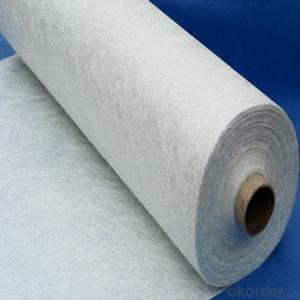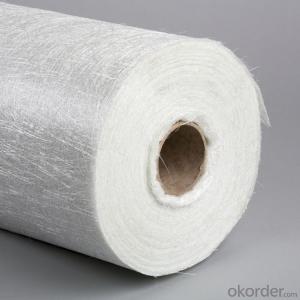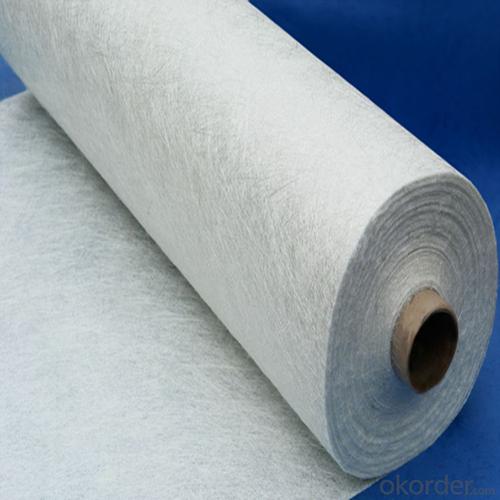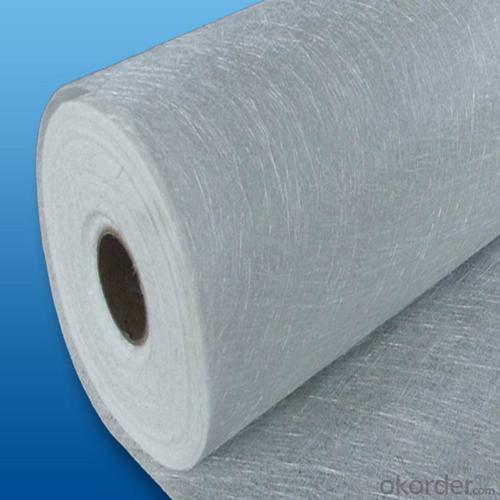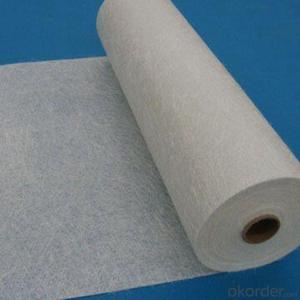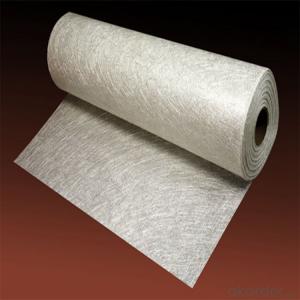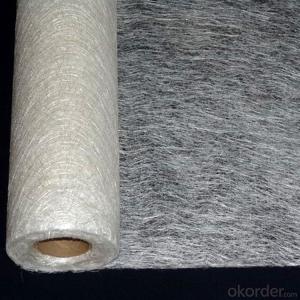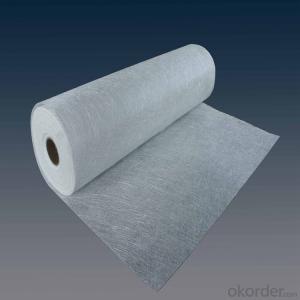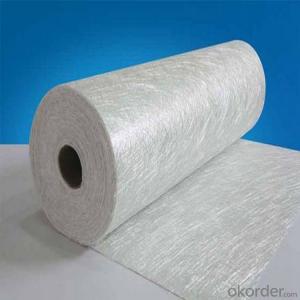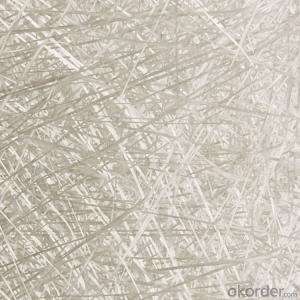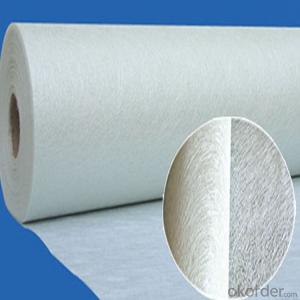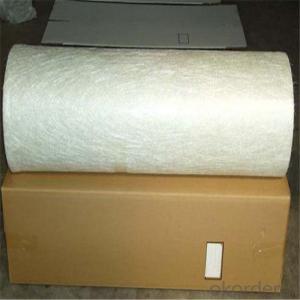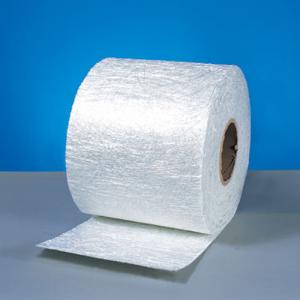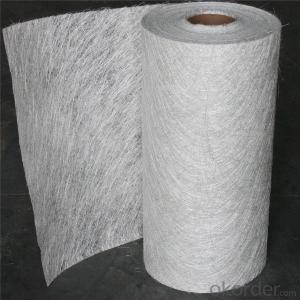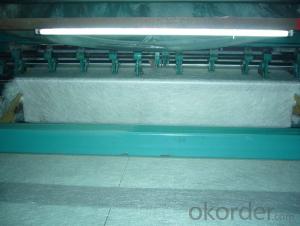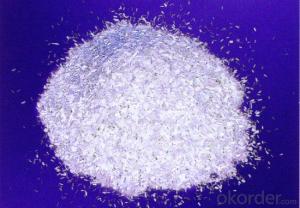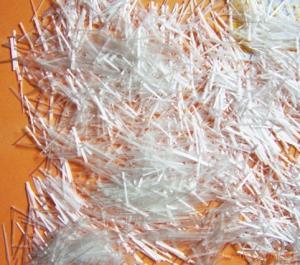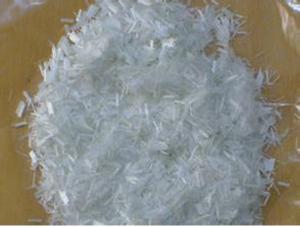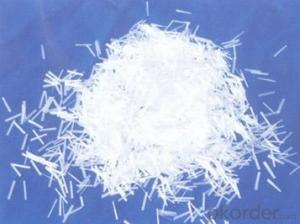Fiberglass Chop Strand Mat E-Glass Fiberglass Chopped Strand Mat
- Loading Port:
- China main port
- Payment Terms:
- TT OR LC
- Min Order Qty:
- 1 kg
- Supply Capability:
- 5000 kg/month
OKorder Service Pledge
OKorder Financial Service
You Might Also Like
Specification
Product Description:
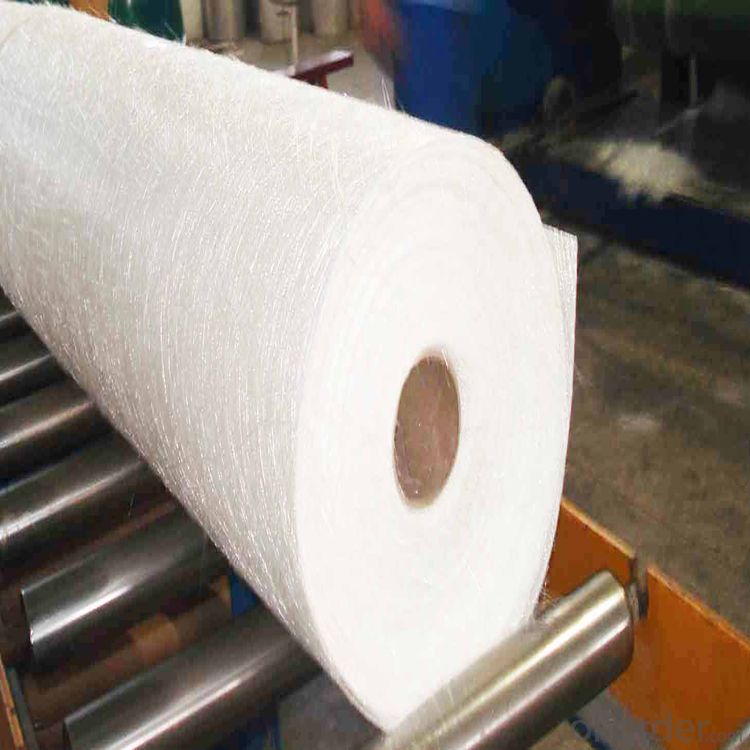
Surfacing Tissue mainly used in the surface layers of FRP products. It features even Fiber distribution, soft feel, level and smooth fiber surface, less glue content, quick resin soak and good pattern fitness. It can improve the product surface property on corrosion resistance, compressive strength, seepage resistance, and longer service life. It is also suitable for spraying; pattern pressing and other FRP pattern technology.
Surfacing Tissue mainly used in the surface layers of FRP products. It features even Fiber distribution, soft feel, level and smooth fiber surface, less glue content, quick resin soak and good pattern fitness. It can improve the product surface property on corrosion resistance, compressive strength, seepage resistance, and longer service life. It is also suitable for spraying; pattern pressing and other FRP pattern technology.
Product Features:
Fast breakdown in styrene
Fiber dispersed evenly
Low binder content
Superior acid corrosion resistance
Specifications:
Item | Over Density | Moisture Content | Chop Density | Polyester Yarn | Width |
(g/m2) | (%) | (g/m2) | (g/m2) | (mm) | |
EMK300 | 309.5 | ≤0.15 | 300 | 9.5 | 50-3300 |
EMK380 | 399 | 380 | 19 | ||
EMK450 | 459.5 | 450 | 9.5 | ||
EMK450 | 469 | 450 | 19 | ||
EMC0020 | 620.9 | 601.9 | 19 | ||
EMC0030 | 909.5 | 900 | 9.5 |
Product Packaging:
Each Surface Tissue is wound onto a paper tube which has an inside diameter of 76mm and the mat roll has a diameter of 330mm. The mat roll is wrapped up with plastic film,and then packed in a cardboard box or wrapped up with kraft paper. The rolls can be vertically or horizontally placed. For transportation, the rolls can be loaded into a cantainer directly or on pallets.

Product Storage:
Unless otherwise specified, Chopped Strand Mat should be stored in a dry, cool and rain-proof area. It is recommended that the room temperature and humidity should be always maintained at 15℃~35℃ and 50%~75% respectively.
Company Information
CNBM (China National Building Material) Group is the largest comprehensive building materials group in China that in integrate scientific research, manufacturing and logistics into one entity. The largest building materials and equipment specialists in China. Upon State Council approval, today CNBM owned more than 300 subordinate manufacturing factories and servicing companies. There are 6 fully owned public listed companies and 11 partially owned with substantial shares public listed companies. In many of these fields, CNBM is playing the leading role in the building industry in the country.
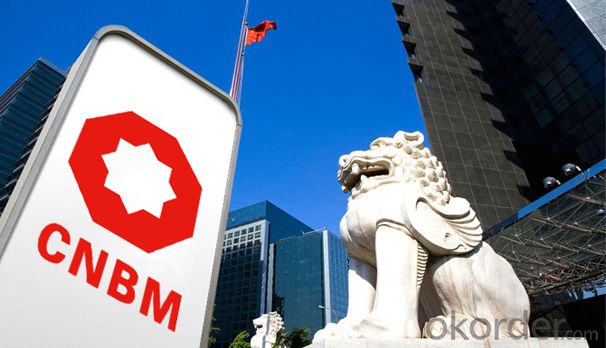
- Q: Is fiberglass chopped strand compatible with different resin systems?
- Yes, fiberglass chopped strand is generally compatible with different resin systems. It can be used with various types of resins such as polyester, epoxy, vinyl ester, and more. However, the compatibility may vary depending on the specific resin system and the intended application. It is important to consult the manufacturer's guidelines and conduct compatibility tests to ensure optimal performance and bonding between the chopped strand and resin system.
- Q: Can fiberglass chopped strand be used in the production of insulation blankets?
- Indeed, the utilization of fiberglass chopped strand is applicable in the manufacturing of insulation blankets. This lightweight and adaptable material possesses exceptional thermal insulation characteristics. It can be effortlessly manipulated and shaped into insulation blankets, which find extensive use in diverse industries for thermal and acoustic insulation objectives. The incorporation of chopped strands effectively augments the overall insulation efficacy of the blankets, forming a compact and consistent layer of insulation material. Moreover, fiberglass chopped strand exhibits resistance against moisture, chemicals, and fire, thus rendering it an optimal selection for insulation applications.
- Q: What are the different surface treatments available for fiberglass chopped strand?
- There are several surface treatments available for fiberglass chopped strand to enhance its performance and compatibility with various materials. Some of the common surface treatments include: 1. Silane treatment: Silane is a widely used surface treatment for fiberglass chopped strand. It involves the application of a silane coupling agent onto the surface of the strands. Silane helps in improving the adhesion between the fiberglass and the matrix material, resulting in enhanced mechanical properties and durability of the composite. 2. Sizing treatment: Sizing is another surface treatment method where a protective coating is applied to the fiberglass strands. Sizing agents typically consist of a combination of lubricants, binders, and other additives. This treatment helps to protect the fibers during processing and handling, and also improves their wettability and compatibility with different resin systems. 3. Plasma treatment: Plasma treatment involves exposing the fiberglass chopped strand to a high-energy plasma gas. This treatment modifies the surface of the fibers by cleaning and activating them, resulting in improved adhesion and wetting characteristics. Plasma treatment is often used to enhance the performance of fiberglass in demanding applications. 4. Chemical treatment: Various chemical treatments can be applied to the surface of fiberglass chopped strand to modify its properties. For example, acid treatment can increase the surface roughness and remove impurities, while alkali treatment can improve the fiber's resistance to moisture and alkali degradation. 5. Coating treatment: Coating treatments involve applying a thin layer of coating onto the surface of the fiberglass strands. These coatings can be made of various materials such as polymers, metals, or ceramics. Coating treatments are often used to provide additional protection against abrasion, UV degradation, or chemical attack, and can also improve the compatibility of the fiber with specific resin systems. Overall, the choice of surface treatment for fiberglass chopped strand depends on the specific requirements of the application and the desired properties of the final composite material. The selection of the appropriate treatment plays a crucial role in optimizing the performance and durability of the composite.
- Q: Is fiberglass chopped strand suitable for renewable energy applications?
- Fiberglass chopped strand is indeed suitable for renewable energy applications. Known for its strength, durability, and corrosion resistance, fiberglass is an excellent choice for various renewable energy applications. For instance, in the field of wind energy, manufacturers commonly use fiberglass chopped strand to produce wind turbine blades. The material's high tensile strength and ability to withstand harsh weather conditions make it a perfect fit for this purpose. Additionally, fiberglass's lightweight properties are crucial in reducing blade weight and maximizing energy production. Moreover, fiberglass chopped strand finds application in the construction of solar panels. Its excellent electrical insulation ensures the efficiency and safety of solar panels. Furthermore, fiberglass's high thermal resistance allows the panels to endure extreme temperatures and have a longer lifespan. Furthermore, hydroelectric power equipment manufacturing can also benefit from the use of fiberglass chopped strand. Its resistance to corrosion makes it suitable for withstanding the harsh conditions found in hydroelectric power plants, including exposure to water and moisture. To sum up, fiberglass chopped strand is a reliable and effective material for a wide range of renewable energy applications. Its strength, durability, and resistance properties make it an ideal choice for wind energy, solar power, and hydroelectric power applications.
- Q: What are the typical thermal expansion characteristics of chopped strand composites?
- The typical thermal expansion characteristics of chopped strand composites are that they exhibit a low coefficient of thermal expansion. This means that they expand very minimally when exposed to heat and contract when cooled, making them suitable for applications where dimensional stability is important.
- Q: Can fiberglass chopped strand be used for ballistic protection?
- To a certain extent, ballistic protection can be achieved using fiberglass chopped strand. Fiberglass is renowned for its impact resistance and high strength, making it suitable for applications like bulletproof vests, armored vehicles, and protective helmets. However, it is vital to acknowledge that fiberglass alone may not offer the same level of protection as specialized ballistic materials such as Kevlar or Dyneema. To enhance its strength and effectiveness for ballistic protection, fiberglass chopped strand is typically combined with other materials like resin or aramid fibers. This combination forms a composite material capable of efficiently absorbing and distributing the impact energy from ballistic threats. The effectiveness of the ballistic protection system depends significantly on its design and construction. Factors like the number of layers, fiber orientation, and overall thickness of the composite structure should be carefully considered to ensure optimal protection. While fiberglass chopped strand can provide a certain level of ballistic protection, it is crucial to consult experts in the field to determine the most suitable materials and design for specific ballistic protection requirements.
- Q: How does the fiber orientation affect the impact resistance of fiberglass chopped strand composites?
- The fiber orientation significantly influences the impact resistance of fiberglass chopped strand composites. When the fibers are aligned in the direction of impact, they can effectively distribute and absorb the applied load, resulting in improved impact resistance. Conversely, if the fibers are randomly oriented or misaligned, the load distribution is less efficient, leading to reduced impact resistance. Therefore, proper fiber orientation plays a critical role in enhancing the impact resistance of fiberglass chopped strand composites.
- Q: Is fiberglass chopped strand compatible with vinyl ester resin?
- Yes, fiberglass chopped strand is compatible with vinyl ester resin. Vinyl ester resin is a type of thermosetting resin that is commonly used in fiberglass composite applications due to its excellent chemical resistance, mechanical properties, and high heat resistance. Fiberglass chopped strand, which consists of short fibers of glass, is often used as a reinforcement material in composite fabrication. When combined with vinyl ester resin, the chopped strand helps to enhance the strength and stiffness of the composite material. The resin binds the chopped strand fibers together, creating a strong and durable composite that is resistant to various chemicals and environmental conditions. Therefore, fiberglass chopped strand and vinyl ester resin are compatible and can be successfully used together in composite manufacturing processes.
- Q: How does fiberglass chopped strand affect the weight of products?
- Fiberglass chopped strand can have a significant impact on the weight of products. Chopped strand is made up of small, cut fibers of fiberglass material. When added to a product or material, it increases its overall weight. This is because fiberglass itself is a relatively lightweight material, but when it is added in the form of chopped strands, it increases the density and weight of the final product. The amount of chopped strand added can be adjusted to achieve the desired weight and strength requirements. Additionally, the length and thickness of the strands can also influence the weight of the product, as longer and thicker strands will add more weight compared to shorter and thinner ones. Overall, the incorporation of fiberglass chopped strand can effectively increase the weight and structural integrity of products.
- Q: How does the adhesion of the chopped strand affect its performance?
- The adhesion of the chopped strand plays a crucial role in determining its performance. The adhesion refers to the bond strength between the individual glass fibers and the matrix material in a composite material. A strong adhesion between the chopped strand and the matrix material is advantageous for several reasons. Firstly, it ensures effective load transfer between the fibers and the matrix, leading to improved mechanical properties such as tensile strength, flexural strength, and impact resistance. The load transfer is essential because the fibers are responsible for carrying the majority of the load in a composite material. A weak adhesion could result in poor load transfer, leading to lower overall performance. Secondly, a strong adhesion helps in preventing fiber pull-out. Fiber pull-out occurs when the fibers are not firmly bonded to the matrix and are pulled out during loading, reducing the efficiency of the composite material. With a good adhesion, the fibers remain embedded in the matrix, providing continuous reinforcement and enhancing the overall strength of the material. Furthermore, a strong adhesion also improves the resistance of the composite material to environmental factors such as moisture and temperature. A weak adhesion can lead to reduced resistance to these factors, resulting in degradation and reduced performance over time. In summary, the adhesion of the chopped strand significantly affects its performance. A strong adhesion ensures effective load transfer, prevents fiber pull-out, and enhances resistance to environmental factors, ultimately leading to improved mechanical properties and durability of the composite material.
Send your message to us
Fiberglass Chop Strand Mat E-Glass Fiberglass Chopped Strand Mat
- Loading Port:
- China main port
- Payment Terms:
- TT OR LC
- Min Order Qty:
- 1 kg
- Supply Capability:
- 5000 kg/month
OKorder Service Pledge
OKorder Financial Service
Similar products
Hot products
Hot Searches
Related keywords
